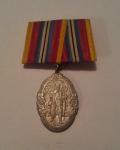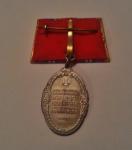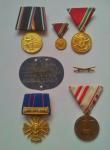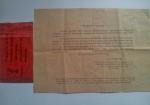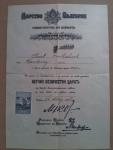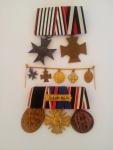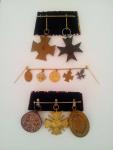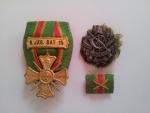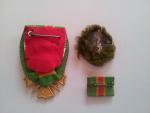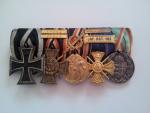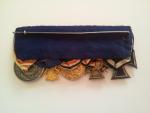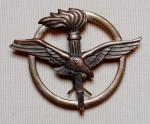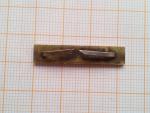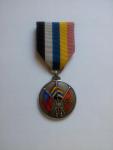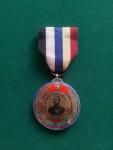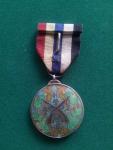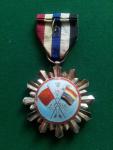-
Posts
306 -
Joined
-
Last visited
Content Type
Profiles
Forums
Blogs
Gallery
Events
Store
Everything posted by j-sk
-
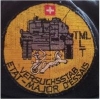
Veteran association award docs....
j-sk replied to Chris Boonzaier's topic in Germany: Weimar Republic & Deutsche Freikorps
Just to complete the POW topic: this rather elaborate medal with its almost next-to-impossible-to-find original ribbon; but without the award certificate, unfortunately. Cheers, Jen-Sam. -

Veteran association award docs....
j-sk replied to Chris Boonzaier's topic in Germany: Weimar Republic & Deutsche Freikorps
Good evening Gentlemen, Here are the medals, documents and the ID tag of the POW Musketier Kurt Maluck, Infantry Regiment 396, brought together. Do note that both Weimar unofficial medals he bought in the early 30's have been mounted for wear, but not the official ones (Bulgarian and Austrian) he received afterwards (about 5 years after the Weimar medals were banned). There must have been a Hindenburgkreuz in the lot as well, but it was not offered when I bought it. Cheers, Jean-Sam. -

Weimar time medal bars
j-sk replied to Claudio's topic in Germany: Weimar Republic & Deutsche Freikorps
I don't think veterans have ever been punished for wearing unofficial medals. After all, they wore them only as a proud "souvenir" of their sacrifice for the "Vaterland", not as an element to be worn officially in a state job. I suppose these rules were mainly applicable to military personnel or police forces "in uniform". Jean-Sam. -

Weimar time medal bars
j-sk replied to Claudio's topic in Germany: Weimar Republic & Deutsche Freikorps
Please note: according to Ulsterman (see his posting under thread: Mistakes in wear), this photo was taken on November 15th 1938... i.e. years after the "unofficial" medals were "officially" banned...! Cheers, Jean-Samuel Karlen -

Weimar time medal bars
j-sk replied to Claudio's topic in Germany: Weimar Republic & Deutsche Freikorps
Hello Lambert, What an interesting "Ordensspange". Although I am always slightly taken aback when it comes to deal with Hindenburgkreuz mixed with other unofficial Weimar medals mounted together on the same bar, this particular group looks original, i.e. mounted before WW2, just like the group in the following picture (taken from the thread "Mistakes in wear"): against all regulations, we can see, from left to right / Hindenburgkreuz for non-combattant / Legion of Honour without the wreath and sword on the ribbon / Flandernkreuz / what looks like a Prussian long service medal / Prussian Red Cross 3rd class medal / Hungarian 1914-1918 non-combattant medal. It is therefore not impossible to find genuine pre-WW2 "Ordensspangen" mixing the Hindenburgkreuz with officially banned Weimar medals !!! In your case, I guess that the original owner replaced himself, on his Weimar 4-medal group, the last unofficial medal (possibly the Kyffhäuserbund medal???) by the newly acquired Hindenburgkreuz and kept the Legion of Honour in its original place in order to "fill the gap" a 3 medal group would have left on a 4 medal bar... Jean-Sam. , -

Weimar time medal bars
j-sk replied to Claudio's topic in Germany: Weimar Republic & Deutsche Freikorps
Here is a group I bought several years ago. Typically, the owner seperated the official crosses from his Weimar group when he received the Hindenburgkreuz, after 1934... but kept the miniatures hanging together on the same chain. -

Weimar time medal bars
j-sk replied to Claudio's topic in Germany: Weimar Republic & Deutsche Freikorps
Addenda: I said "to a certain extent", because as shown on the following pictures, the two elderly veterans did not seem to apply strictly to the rules... One with both Kyffhäuser-Denkmünze and Hindenburgkreuz (...unless the photo was taken between 1934 and 1936...). The "medic" wearing the Hindenburgkreuz together with the Kyffhäuser-Denkmünze with six campaign clasps (when only five were authorized for wearing on the ribbon), a cross that looks like the Bayerisches Kriegs-Erinnerungskreuz (definitely banned after 1934) and several other crosses issued years after the Weimar medals (including the Kyffhäuser-Denkmünze) were banned... Weird as it seems, what would be considered as fake is in fact reality... since photos never lie (see this link for clearer pictures: http://antique-photos.com/en/awardsdatabase/weimarawards/223-kriegsgedenkmunze.html). Jean-S. -

Weimar time medal bars
j-sk replied to Claudio's topic in Germany: Weimar Republic & Deutsche Freikorps
Yes, to a certain extent. At least on full size medal bars. The only Weimar medal authorized after 1934 -- but only until 1936 -- was the oval Kyffhäuser-Denkmünze (see: http://www.ehrenzeichen-orden.de/weimarer-republik/kyffhauser-denkmunze-fur-191418.html). But this rule seems to apply on full size bars only because I have seen miniature groups and ribbon bars sporting the Hindenburkreuz together with other Weimar unoffcial medals... but why... Jean-Sam. -

Weimar time medal bars
j-sk replied to Claudio's topic in Germany: Weimar Republic & Deutsche Freikorps
Actually, no. The Hungarian medal was issued in May 1929 (see: http://de.wikipedia.org/wiki/Ungarische_Weltkriegs-Erinnerungsmedaille). The unofficial medals (Flandernkreuz/Deutsche Ehrendenkmünze des weltkrieges/Regiments-Erinnerungskreuz) were banned from medal groups in 1934 onwards and replaced by the Ehrenkreuz des Weltkrieges (Hindenburgkreuz; see:http://de.wikipedia.org/wiki/Ehrenkreuz_des_Weltkrieges) issued in July 1934. This group must therefore have been set up between mid-1929 and mid 1934. Jean-Sam. -

Weimar time medal bars
j-sk replied to Claudio's topic in Germany: Weimar Republic & Deutsche Freikorps
Here are two of my latest (and rather interesting) acquisitions: - Bataillons-Erinnerungskreuz, Reserve Jäger-Bataillon Nr. 15 + associative badge; - Group of five with YPERN - SOMME- RUMÄNIEN clasps, Königlich Sächsisches 16. Infanterie-Regiment Nr. 182 (Freiberg), XIX Armee Korps. Cheers, Jean-Samuel Karlen -

Weimar time medal bars
j-sk replied to Claudio's topic in Germany: Weimar Republic & Deutsche Freikorps
Quite probably, but not forcibly! All Saxon infantry regiments wore red-piped dark blue shoulder-boards. Unless this Saxon soldier was incorporated in a non-Saxon infantry regiment (Bavarian or Prussian), the ribbon should inevitably be dark blue / red / dark blue / red / dark blue. I therefore looked for cavalry regiments. The only plausible regiment present in the Flanders and Verdun is the Königlich Sächsisches 1. Husaren-Regiment "König Albert" Nr. 18 (Grossenhain), XII Armee Korps, which was part of the 32. Division (3. Königlich Sächsische). The uniform of this 18. Saxon Hussars also sports some caracteristics of the ribbon: blue attila, yellow braiding and red Kolpak. Am I right, am I wrong in my guessing, it is hard to tell since Firma Paul Küst and its archives vanished into thin air after Berlin was bombed to the ground in 1945. I hope this help. Cheers, Jean-Sam. -

Weimar time medal bars
j-sk replied to Claudio's topic in Germany: Weimar Republic & Deutsche Freikorps
Very nice ribbon bar. I do not find it particularly weird to see a VERDUN bar on a Flandernkreuz ribbon. Such bar was actually produced by Paul Küst for this cross (see: HüSKEN, Katalog der Auszeichnungen des Deutschen Reiches 1871-1945; Fa. Paul Küst Berlin; page 120). Regarding the last ribbon, it is the Regiments(Bataillons)-Erinnerungskreuz. There were various ribbons issued for this cross. This blue-yellow-red-yellow-blue ribbon indicates a regiment/bataillon wearing red shoulder-boards and yellow cypher/number on the blue peace-time tunic. Cheers, Jean-Samuel Karlen -

Unidentified Unknown air force badge - Any idea?
j-sk replied to j-sk's topic in Northern European & Baltic States
Thank you all for your help and for the Italian lead. It eventually help me find THE solution: it is an Italian beret badge worn by members of the Italian Army Air Force (link: http://it.wikipedia.org/wiki/Aviazione_dell'Esercito). See below a similar badge sold on eBay.it by 'italiamilitare': Fregio da Basco AVIAZIONE DELL'ESERCITO aves in Metallo e Nuovo All the best, Jean-Samuel Karlen -

Unidentified Unknown air force badge - Any idea?
j-sk replied to j-sk's topic in Northern European & Baltic States
Could it be French...? -

Unidentified Unknown air force badge - Any idea?
j-sk posted a topic in Northern European & Baltic States
Hello Gentlemen, Does anybody know this badge? Obviously an Air Force one, possibly of an instructor (see the torch), but from which country? Thanks for letting me know. Cheers, Jean-Sam. -
Good evening Gentlemen, As for many unofficial commemorative crosses issued during the Weimar Republik (1919-1934), the so-called "Regiments-Erinnerungskreuz" can be found either with or without swords. One would usually think that the cross without the swords would normally be attributed to non-combattant troops (medical staff, chaplains, etc.)... BUT... since I bought the "Katalog der Auszeichnungen des Deutsches Reiches 1871-1945", 3rd completed edition 2012, published by Hüsken, my certainties were slightly shaken. Pages 125-126, under "Regiments-Erinnerungskreuz", number 02.08.55/5 reads as follows: "ohne Schwerter für Kriegsgefangene", i.e.: (cross) without swords for prisoners of war...! What about the non-combattants? There is NO mention of them whatsoever. Hüsken also mentions (see number 02.08.55/2) a "Treu der Division" cross. I know that division unit bars do exist, but I have never seen any cross with "Treu der Division" inlay so far. Could anyone confirm that Hüsken is right (or wrong), that he did not "forget" the non-combattants, or does anyone of you have a plausible explanation about all that ? Thank you in advance for your expertise! Jean-Sam.
-

Combat bar TANNENBERG / Repro or original?
j-sk replied to j-sk's topic in Germany: Weimar Republic & Deutsche Freikorps
In the mean-time I found this interesting site: http://ksmvb.gmxhome.de/pages/kyffh_spangenpag.html It states that the Kyffhaeuserbund bars are 35mm wide...! Although this TANNENBERG bar looks very much like a Kyffhaeuserbund bar, it is only 32,5mm wide... Could it therefore be a later production or just a mere copy? J-S Karlen -

Combat bar TANNENBERG / Repro or original?
j-sk replied to j-sk's topic in Germany: Weimar Republic & Deutsche Freikorps
Thank you Hardy for your comment. Jean-Sam. -
And as we say, here, in this French-speaking-Lake-of-Geneva part of Switzerland: "Tout est bien qui finit bien!"
-
Yes, I can consider myself lucky: 1) to have found this medal for a starter, and 2) to have been able to complete it with the right - although from a weird provenance - ribbon.
-
And here is the medal, with the adequate "Hungarian Chess Championship" ribbon... That really makes the difference! All the best to you all, Jean-Samuel Karlen.
-
Fair enough: you get the medal and I keep the ribbon... provided we split the costs in two ;-) Unless someone turns up with an original one in the mean-time...
-
You are quite right about the ribbon. By the way, here are two of my "Wu Peï Fu" medals, with matching original ribbons. Although looking globally similar to your medal (see #18), how many different types and models of these were made...? Cheers, Jean-Sam.
-
Thanks JapanX for the tip! I'll do my best to get that Hungarian medal... even though I am only a mere amateur in chess !


